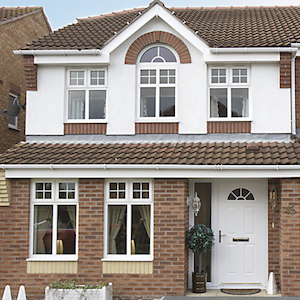A Window in the Door: More than Just a Pane of Glass
Initially look, a window in a door might appear like an easy architectural function. It's just a piece of glass that permits light to filter through or offers a glimpse of what's on the opposite, right? However when you pause to consider it, this relatively mundane element carries substantial practical, visual, and even symbolic weight. Whether it graces the doors of your home, office, or favorite café, a window in a door is even more than simply a pane of glass-- it's a bridge in between areas.
1. Performance: The Practical Role of Door Windows
The addition of a window to a door offers useful advantages that can improve both residential and industrial areas:
Natural Light: One of the main functions of a window in a door is to allow sunlight to travel through. In french doors and side windows with limited windows or confined areas like corridors or interior workplaces, this feature can brighten the area, decrease the reliance on artificial lighting, and create a more inviting environment.
Presence and Safety: A window in a door offers a clear line of sight for those on either side. This is specifically essential in industrial and industrial settings, such as restaurants, factories, or schools, where individuals often move through doors. Visibility decreases the risk of mishaps (e.g., somebody walking into a door or clashing with someone on the other side).
Ventilation and Energy Efficiency: When coupled with operable glass or modern-day technologies like double-glazing and low-E glass, door windows can contribute to much better air blood circulation and energy efficiency in your home or work area.
Security: While breaking glass may seem like an open invite to burglars, contemporary styles have addressed this issue. Reinforced glass, tempered glass, or styles with narrow panes can make the window resistant to break-in while still satisfying of visibility and light.
2. Visual Appeal: Enhancing the Visual Identity of a Space
From a design viewpoint, windows in doors can elevate visual appeal in many methods:
Design and Character: The design of the window frequently matches the architectural ambiance of the property. A home with a rustic or farmhouse look might feature a door with frosted or stained glass, while a sleek, modern home may showcase a minimalist door with easy, clean lines.
Customization: Door windows can be found in numerous shapes and sizes-- round, rectangle-shaped, oval, arched, or custom-designed to match your choices. This flexibility provides house owners and designers the ability to produce doors with creative style and individual touches.
Curb Appeal: The entry door is typically the focal point of a home's exterior, and a properly designed window within it can turn an otherwise common door into a vibrant style statement. Frosted or etched glass, for circumstances, can communicate sophistication and elegance.
3. Importance and Meaning: Beyond the Practical and Aesthetic
On a much deeper level, a window in a door carries symbolic meanings that resonate across cultures and contexts:
Openness and Connection: A door with a window cultivates a sense of connection between two discrete spaces. Whether it's in between a home and its front yard or a workplace conference room and a hallway, the window can make these spaces feel less separated and more integrated.
Transparency: In offices, doors with windows signify openness and accountability. A supervisor's workplace with a glass-panel door, for example, can signal approachability, reducing the hierarchical barrier that a strong closed door might produce.
A Threshold of Opportunity: Metaphorically speaking, a door with a window can represent a view into new chances. It uses a preview into what lies ahead-- a fitting image for personal growth and expedition.
4. Modern Trends: Innovations in Door Window Design
Advances in innovation and style are continuously reshaping how we consider door windows. Here are a couple of trends to see:
Smart Glass: With the introduction of clever innovation, windows that can alter from transparent to opaque with the touch of a button are acquiring appeal. These state-of-the-art options offer privacy as needed without sacrificing the benefits of natural light.
Energy Efficiency: Double- and triple-glazed door windows with advanced insulation are ending up being requirement in energy-conscious homes. These not only keep your energy expenses in check however likewise lower ecological impact.
Ornamental Enhancements: Patterns, etching, and colored glass inserts are becoming more detailed, offering property owners unlimited possibilities to customize their doors.
Security Upgrades: Impact-resistant glass and shatter-proof movies are progressively being integrated into door windows, particularly in areas prone to storms or high-security requirements.
5. Considerations for Choosing a Door with a Window
Before choosing a door with a built-in window, there are a couple of elements property owners and designers ought to keep in mind:
Privacy: While a window provides presence and natural light, it can likewise jeopardize personal privacy. Frosted glass or tactically put window styles can reduce this issue.

Upkeep: Glass in doors will collect fingerprints, dirt, and spots, especially in high-traffic locations. Choosing products that are simple to tidy or have protective coatings can conserve time.
Combination with the Environment: Choose a door window design that matches the environments. A door in a quiet, residential area might focus on aesthetics, while one in a commercial building may stress sturdiness and security.
Conclusion: A Small Feature with Significant Impact
As simple as it may appear, a window in a door is a feature that blends practicality with beauty, safety with style, and connection with uniqueness. It's a pointer that the smallest details in architecture can have the power to transform not just our spaces but likewise the way we engage with them.
Whether you're peering through a glass panel to invite a visitor or letting natural light filter into your home, a window in a door is much more than a style component-- it's a way to open ourselves to the world, one pane of glass at a time.
